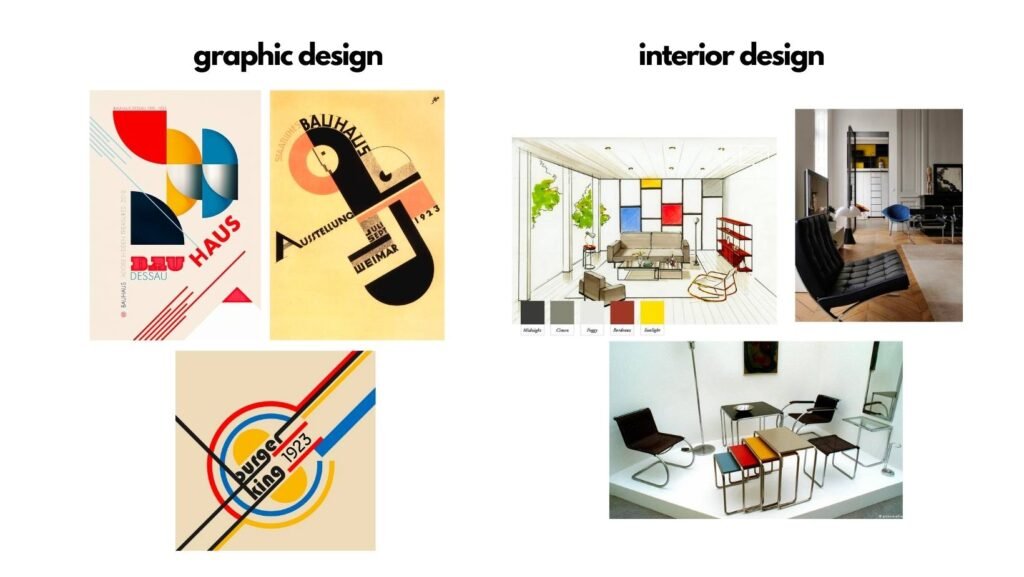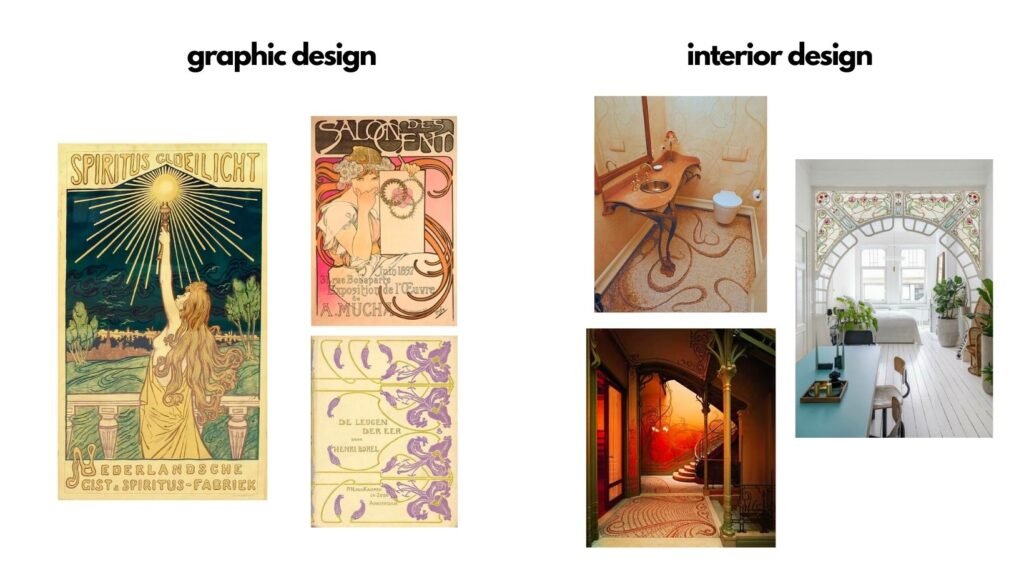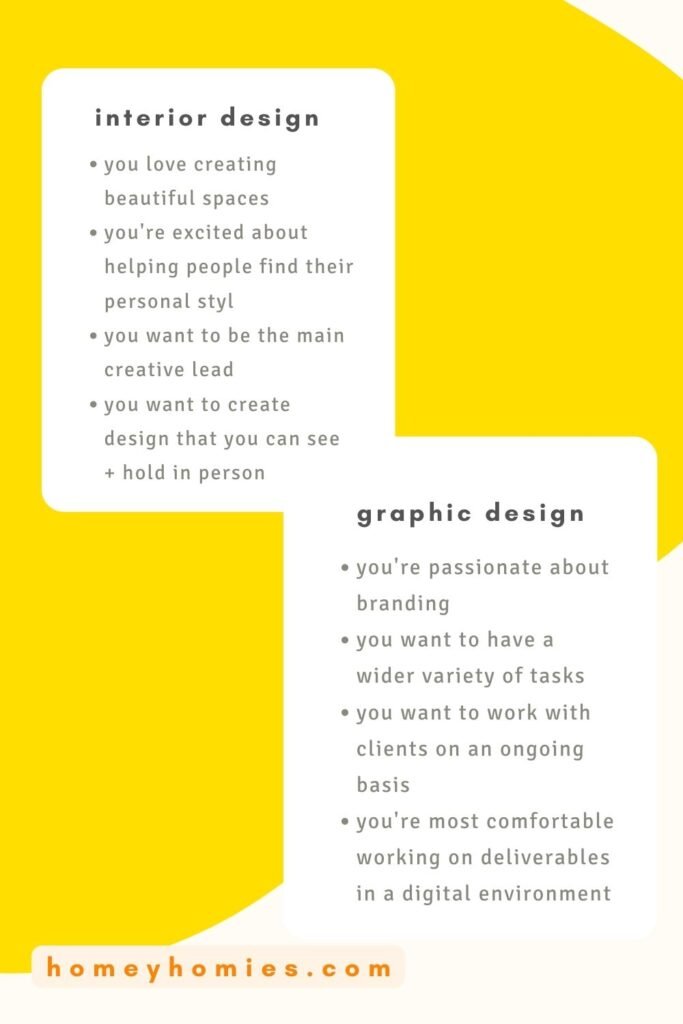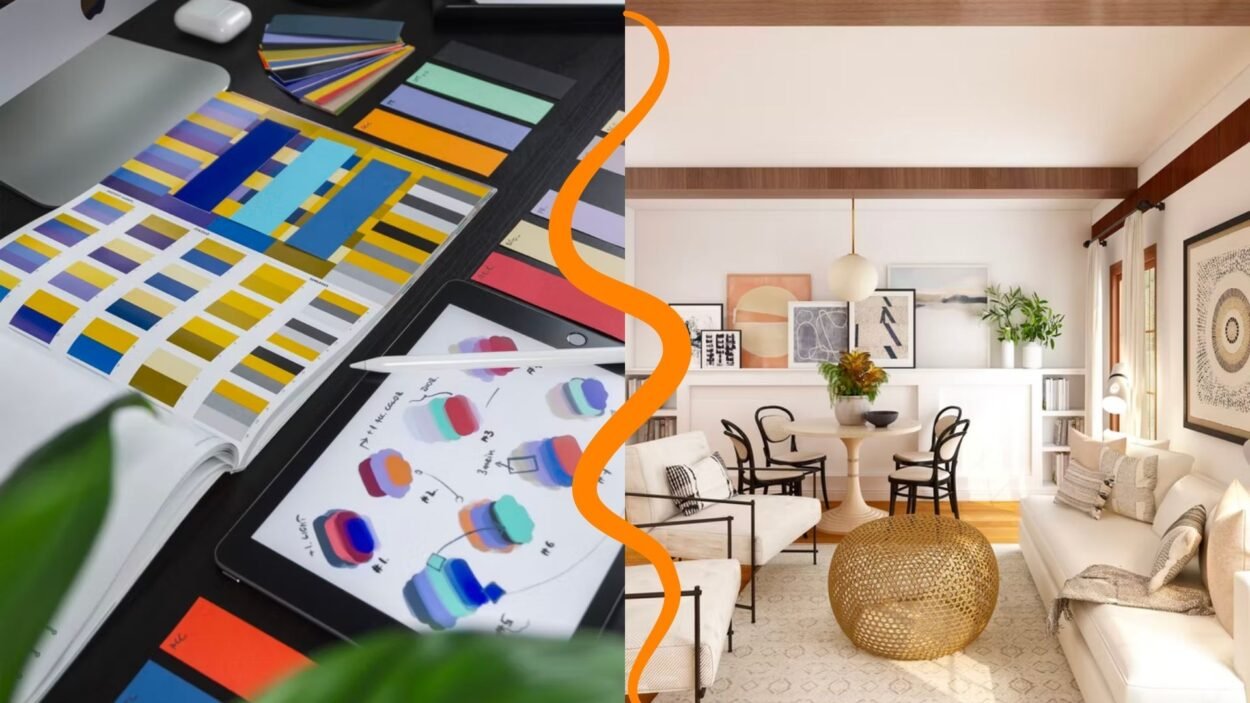Design is design, right? Well, not exactly. Graphic design vs interior design is one topic that often arises for people looking to pursue a design career. But you may be wondering what exactly are the overlaps and the differences? Which path fits you best? How do trends from the two different disciplines interact?
In this post, I’m gonna answer all those questions for you. So whether you’re doing research on trends, are trying to decide which career to pursue, or are wondering if you can switch your career from one to the other, I’ve got you covered.
What this post will cover (you can click on any topic to jump to that section!)
The similarities
The differences
How trends from graphic design and interior design affect each other
Graphic designers and interior designers working together
Which should you pursue: graphic design vs. interior design?
The similarities between graphic design vs. interior design
Both graphic and interior design are creative disciplines that revolve around design. Although the execution and the end product looks different for both disciplines, at their core they are still under the umbrella of design. And that means that these professionals need to have a knowledge of both aesthetics as well as more concrete, strategic skills.
When compared with other artistic endeavors – like painting or sculpting, for example, both of interior design and graphic design are not simply art for art’s sake. They are generating creative works that serve a practical purpose. Whether that is creating a place for someone to inhabit or creating a brand identity for a company.
Visual communication
Clear visual communication is critical for both graphic design and interior design. This is due to the aforementioned fact that these creative projects are created to serve a specific purpose. And this often involves communicating creative ideas to people who are not experts in design.
In interior design, this often involves creating floor plans, mood boards, 2D or 3D renderings, elevations, and more. Prior to executing the final product – i.e. building, renovating or furnishing the space – it’s crucial to give clients a peek into what they can expect. That’s what these visual deliverables do. A client may not be able to picture in their head what a raised ceiling with exposed beams, ashy herringbone floors, and an open floor plan looks like in their head. This visual communication component bridges that gap to ensure that you can communicate the ideas in your head.


And of course, the act of creating the final space itself is another form of visual communication, albeit more concrete and tangible.
In graphic design, visual communication is also crucial. In branding projects, logo creation, or product design, the graphic designer translates a written or spoken visual identity or brand story into visual product. This could be a variety of deliverables, including a mood board, logo, social media graphics, website design, product packaging, and more.


The overlap between interior design vs graphic design professions
Design principles are easily transferrable between disciplines. If you have a grasp on interior design principles, you will have a basic understanding of some of the underlying principles of graphic design. And same the other way around. This is because a design-focused mentality helps these individuals constantly be flexing their creative muscles while still considering the practical components as well.
And while there are some definite distinctions between the skills and requirements for interior design vs graphic design professionals, you will often notice an overlap between the two professions. Many graphic designers may have started as interior designers and vice versa. While some may go the self-taught route and others may choose to go back to school, the interest in these two fields are commonly intertwined.
So clearly, graphic design and interior design have a lot in common. But they are two distinct fields for a reason. Let’s get into what some of the key differences are.
The differences between graphic design vs interior design
The starkest difference between graphic design and interior design has to do with the final product. In graphic design, designers create a 2D product. Although it can be translated into a 3D application (in things such as packaging), it is still essentially a 2D product. In interior design, designers create 3D products. These products are tangible and you can interact with them in real life.
Although interior designers do some work digitally – such as the visual communication pieces mentioned earlier – the actual final product is 3D. They work with furniture, finishes, fixtures, and paint to execute their creative vision. The medium by which graphic designers work is typically digital. Although they may incorporate some physical art, they typically scan and manipulate it in a digital platform.
Education
Education is another key component. Although it is common for individuals to go through traditional schooling (i.e. college or university) for each of these disciplines, a degree is typically less relevant for graphic design.
It’s is much easier and more common to be a self-taught graphic designer. There are several online tutorials, videos, and articles that people can use to learn graphic design. Several people do get an associates, bachelor’s or master’s degree in graphic design. But it’s possible to get hired with a solid portfolio and no degree.
Interior design, on the other hand, typically requires a degree. Since interior design often requires an advanced understanding of rules and regulation surrounding building as well as the drafting of technical documents, it’s important to have a degree. Especially if you want to get hired by a professional firm.
Some designers are self-taught. However these individuals would be considered more of an interior decorator. An interior decorator does not deal with renovations, electrical wiring, etc. They simply decorate an existing space without altering the foundation. These skills are easier to teach yourself.
Collaboration
Both disciplines can work either collaboratively or independently. However, collaborative work in interior design is much more common. Interior designers typically collaborate with more tradespeople like contractors, electricians, etc. Architects are another common collaborator.
Graphic designers, when they collaborate, typically work with other creatives. These creative professionals can be artists, illustrators, and animators.
Industries
A major difference between graphic design vs interior design is the context in which these professionals are hired.
Graphic designers are most commonly associated with corporate branding. While they may occasionally be hired for personal purposes (i.e. wedding or party invitations), their work is most common in a business setting.
Interior design is more common in personal residential settings. People will hire interior designers to create their dream homes. There is also a large market for commercial interior design in offices and especially in the hospitality industry in spaces like hotels. However, the residential side of the business is slightly more popular.
How trends from graphic design and interior design affect each other
All areas of design historically have a back and forth exchange. New trends in one discipline usually pop up in the other disciplines as well. This is true in graphic design, interior design, fashion, art, furniture, and more. All of these creative industries feed off of the same historical context – politically, socially and culturally – and new materials, so it’s clear why there would be an overlap.
Let’s take a look at some of the historical relations between graphic and interior design:
Bauhaus (1919-2933) – This was an overarching design discipline that was all about whittling down design to its most basic components. There’s a large focus on geometry, minimalism, and simple color scheme. One of the core tenets of this school of thought was to unify all of the arts. So the overlap is extremely obvious.


Art Nouveau (1890-1910) – This is a highly ornamental design style that drew a lot of inspiration from nature. Art nouveau was expressed in design through things like asymmetry, curves, plant-like embellishments, and mosaics.


These overlaps continue today. If you take a look at this post from Xponent21, you see how trends continue to jump back and forth between interior and graphic design. From popular colors like sage green, to mismatched patterns, to biophilic design.
How can graphic and interior designers work together?
Since there is so much overlap in the two professions, it seems natural that they would work together from time to time.
The most common instance in which graphic and interior designers work together is on branding projects. Branding is all about communicating the essence of a company. And to do this, you often need a branded office or retail space, as well as marketing assets. Once a brand story is created, both designers excel at communicating this story through design in a really cohesive way.
Another common way that graphic and interior designers work together is through hospitality. This is arguably one of the most design-driven industries. Businesses in these industries want to create an experience for their guests. So when designers work together to create beautiful spaces that help guests escape and unwind, and a brand identity goes along with it, these businesses thrive.
Overall, the most common way in which interior designers and graphic designers collaborate is through corporate projects.
Which should you be: graphic designer or interior designer?
You may find yourself at a crossroads deciding which career to pursue. Or perhaps are switching from one design field to the other. I’m here to help you figure out which one may fit you best. Let’s take a look at the interest and skillset that’s ideal for each discipline.
An interior designer…
- Loves creating beautiful spaces
- Is excited about helping an individual find and communicate their personal style
- Prefers being the main creative lead – but is comfortable working with tradespeople
- Wants to create design that you can hold, sit on, and move around
One thing I want to note here, is that you can still incorporate graphic design in the business side of interior design!
Take me, for example. I do freelance interior design and run an interior design blog, and I use graphic design every day. From creating my logo, designing graphics for blogs and social media, stationary, and so much more, I get my fix for graphic design while pursuing my main passion in interior design. (Taking certification courses on sites like coursera has been great for enhancing my graphic design skillset, by the way!)
A graphic designer…
- Is passionate about helping businesses create a compelling and consistent brand
- Loves the idea of having a wider variety of tasks on their plate (i.e. creating logos, websites, downloadables, etc.)
- Wants to work with clients on more of an ongoing basis
- Is more comfortable creating projects in a digital environment


About me
Hey my name’s Hannah Michelle Lambert, the voice behind homey homies. I’m an LA-based designer, writer, and content strategist. I’m passionate about the intersection of productivity and creativity. I love talking about creative habits, technology, processes, and everything in between that helps me blend the Type A and Type B parts of my brain.






Leave a Comment